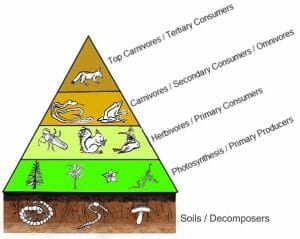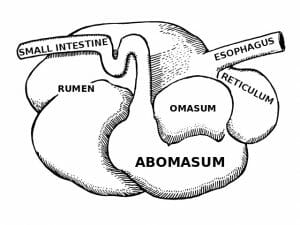Primary Consumer Definition
A primary consumer is an organism that feeds on primary producers. Organisms of this type make up the second trophic level and are consumed or predated by secondary consumers, tertiary consumers or apex predators.

Primary consumers are usually herbivores that feed on autotrophic plants, which produce their own food through photosynthesis. Several other feeding strategies are also used by primary consumers: algivores feed on photosynthetic algae; frugivores feed on the fruiting bodies of plants; nectarivores feed on plant nectar; folivores feed on leaf material; granivores feed on grains and seeds while fungivores feed on heterotrophic fungi such as mushrooms. Many primary consumers adopt several different feeding strategies in order to maximize the effectiveness of foraging behavior.
Primary consumers often have specific physiological adaptions that allow them to process the carbohydrates produced through photosynthesis, which can be hard to break down and extract nutrition from; herbivores often have rows of wide, flat teeth are used to rasp, grind and tear tough plant material and woody stems. Many primary consumers also have symbiotic bacteria, which live within a special organ called the cecum and assist with the digestion of plant material.
Primary consumers exist in all biomes and fill a wide variety of niches. They can range from microscopic organisms such as zooplankton to animals as big as elephants.
Examples of Primary Consumers
Ruminants
Ruminants such as cows, sheep, deer, giraffes and goats are herbivore primary consumers, which graze or browse on plant material like grasses, herbs, leaves and twigs. Because the cellulose found in the cell walls of plants is hard to break down, ruminants have adaptions which allow them to acquire the nutrition using fermentation and digestion within four specialized chambers of their stomach.
Cows graze on plant material with a side-to-side motion, grinding the grass against a tough area of skin on the roof of the mouth (instead of top front teeth), called the dental pad. The chewed material is then passed into the first two digestive chambers, the ‘rumen’ and the ‘reticulum’, where the food is mixed with saliva and separated into liquid form and solid clumps called ‘cud’. The cud is then regurgitated and further chewed, to reduce down the particle size of the food. It is then passed back into the two chambers, where the fibrous cellulose is broken down by protozoans, bacteria, fungi, and yeasts. The partly digested material is then moved into the third chamber, the ‘omasum’, where the liquids are absorbed into the blood stream. Next, the material is moved into the fourth stomach, the ‘abomasum’. This chamber is the most similar to the stomach of non-ruminants, and contains gastric acids which further break down the food. Finally, the material is passed to the small and large intestines, where true digestion i.e. the absorption of nutrients and further fermentation occurs.

The complexity of the ruminant stomach demonstrates the difficulties that large animals have in extracting sufficient nutrients from plant carbohydrates. However, the volatile fatty acids and proteins that are produced as a consequence of this system form an extremely important component of the human diet.
Zooplankton
Zooplankton are the microscopic organisms which exists as drifting organisms suspended in the oceans. These include protozoans, as well as metazoans (animals) that are in their juvenile form, such as jellyfish, mollusks and crustaceans
Almost all zooplankton are heterotrophic, which means they acquire their nutrition from theorganic carbon produced through photosynthesis. Photosynthesis is performed by the primary producers of the oceans, which convert inorganic carbon into usable energy; these are autotrophic algae known as phytoplankton.
Most zooplankton that are primary producers feed by filter feeding. In this feeding strategy, water, containing phytoplankton, is passed over specialized filtering structures and the phytoplankton are filtered out and digested.
Herbivorous birds
Many species of birds are either carnivores or omnivores, and so they occupy higher trophic levels than herbivorous birds. However, many birds feed on only fruit, seeds and berries and so they are at the level of primary consumer within the trophic pyramid
Birds, which specialize on a diet of plant matter, often have morphologically adapted beaks, which allow them to exploit their food source. , Toucans, parrots and parakeets have extremely strong beaks, which help them to crack nuts, which additionally act as a stabilizing device for climbing high trees to reach high-growing fruits. Hummingbirds and other nectarivorous birds usually have very small body sizes, and long, needle-thin beaks, which allow them to access nectar sources deep within the bodies of flowers. Many budgies, canaries and finches have a diet consisting of grains and seeds, so they have short, tough, pointed beaks, which allow them to pick up seeds with great precision.
Related Biology Terms
- Primary Producer – An organism that uses energy from sunlight to manufacture its own food.
- Secondary Consumer – An organism which eats other heterotrophs, usually called carnivores or omnivores.
- Trophic Level – Each of the levels within a food chain, in which animals fill the same nutritional role.
- Food Web – The complex system of food chains and nutritional dispersal within an ecosystem.
Quiz
1. Primary consumers fit in to ________________ trophic level.
A. the first
B. the second
C. the third
D. any
2. Which is not likely to be an adaption to a diet of consuming primary producers?
A. Filtering systems
B. Dental pads
C. Sharp teeth
D. Symbiotic gut bacteria
